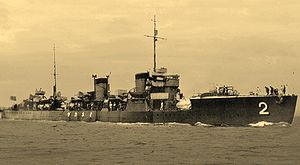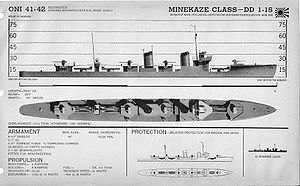- Minekaze class destroyer
-

Minekaze at Yokosuka, 1918Class overview Builders: Maizuru Naval Arsenal
Mitsubishi-NagasakiOperators:  Imperial Japanese Navy
Imperial Japanese Navy
 Republic of China Navy
Republic of China NavyPreceded by: Momi class destroyer Succeeded by: Wakatake class destroyer Subclasses: Nokaze class destroyer In commission: 1919–1946 Completed: 15 Lost: 11 Retired: 4 General characteristics Type: Destroyer Displacement: 1,345 long tons (1,367 t) normal,
1,650 long tons (1,680 t) full loadLength: 97.5 m (320 ft) pp,
102.6 m (337 ft) overallBeam: 9 m (30 ft) Draught: 2.9 m (9.5 ft) Propulsion: 2-shaft Mitsubishi-Parsons geared steam turbine, 4 heavy oil-fired boilers 38,500 ihp (28,700 kW) Speed: 39 knots (72 km/h) Range: 3600 nm at 14 knots
(6,700 km at 26 km/h)Complement: 148 Armament: 4 × Type 3 120 mm 45 caliber naval gun
2 × 7.7mm machine guns
6 × 53cm torpedoes
20 × minesThe Minekaze class (峯風型駆逐艦 Minekazegata kuchikukan) was a class of fifteen 1st-class destroyers of the Imperial Japanese Navy.[1] Obsolete by the beginning of the Pacific War, the Minekaze class ships were relegated to mostly secondary roles, serving throughout the war as patrol vessels, high speed transports, target control vessels, and as kaiten (suicide torpedo) carriers. Most ultimately were lost to U.S. and British submarines.
Contents
Background
Construction of the large-sized Minekaze-class destroyers was authorized as part of the Imperial Japanese Navy's 8-4 Fleet Program from fiscal 1917–1920, as an accompaniment to the medium sized Momi-class with which they shared many common design characteristics.[2]
Equipped with powerful engines, these vessels were capable of high speeds and were intended as escorts for the projected Amagi class battlecruisers, which were ultimately never built.[3]
Two vessels were authorized in fiscal 1917, and an addition five in fiscal 1918. Although none had been completed by the end of World War I, the Japanese Navy decided to continue the project as many older destroyers were in need of replacement. An additional five vessels were ordered in fiscal 1919, and a final three in fiscal 1920. However, the final three vessels were built to a different design and have a different enough silhouette that they can be regarded as a separate sub-class.[4]
The new destroyers were fast and powerful ships that were equal to any of their foreign contemporaries.[5]
Design
Coming between the foreign designed vessels of the earlier part of the century and the innovative Kagero and Fubuki 'Special Type' destroyers of the 1930s, the Minekaze-class was a significant transitional design for the Imperial Japanese Navy. Minekaze represented a complete break from previous practice of closely following British designs and methods.
The Minekaze class incorporated a number of distinctive design innovations including a lengthened forecastle with a break forming a well deck immediately forward of the bridge. This arrangement offered the advantage of a low, semi protected area for the forward torpedo tubes albeit at the cost of becoming awash in heavy seas.[6]
The engines utilized four Kampon boilers running two-shaft geared turbines at 38,500 shp, yielding a rated speed of 39 knots (72 km/h). However, as with previous designs, high fuel consumption meant limited range.
Armament consisted of four Type 3 120 mm 45 caliber naval guns, six 21" torpedo tubes in three sets of double launchers and two 7.7 mm machine guns. Ships of this class could also be equipped to carry up to 20 mines.[7]
Nokaze sub-class


Aft view of Namikaze showing revised weapons layout of the Nokaze sub-class The final three vessels in the Minekaze series incorporated a number of improvements gained through operational experience, and form a separate sub-class. The primary difference was in the arrangement of the aft armament. With the Minekaze-class, the aft guns were pedestal-mounted along the centerline, with two double torpedo launchers in between. This severely limited the arc of fire of the No. 3 gun. The improved design had a better gunnery fire control system and improved ammunition magazine arrangements. Gun and torpedo positions were changed: the No. 3 gun formerly mounted aft of the second funnel was moved further aft to the "X" position. Torpedo mounts No. 2 and No. 3 were moved closer together and the searchlight platform formerly between them was moved forward to just aft of the second funnel.[8]
Operational history
Commissioned during the 1920s, the Minekaze class ships were the mainstay of the Imperial Japanese Navy destroyer squadrons throughout the 1930s until gradually replaced by more advanced types.
In 1938, Okikaze was disarmed, but in 1941 with the war fast approaching she remounted her guns. Nadakaze and Shimakaze were derated to patrol boats in 1939 and 1940. In 1939 Sawakaze was used as an aircraft rescue ship at Tateyama Naval Air Station, but reverted to her original role at the outbreak of the war.[9]
List of Ships
Kanji Name Builder Laid down Launched Completed Fate 峯風 Minekaze Maizuru Naval Arsenal, Japan 1918-04-20 1919-02-08 1920-05-29 Torpedoed E of Taiwan [23.12N, 121.30E] 1944-02-10; struck 1944-03-31 澤風 Sawakaze Mitsubishi-Nagasaki, Japan 1918-01-07 1919-01-07 1920-03-06 Retired 1945-09-15; scuttled 1948 沖風 Okikaze Maizuru Naval Arsenal, Japan 1919-02-22 1919-10-03 1920-08-17 Torpedoed S of Yokosuka [35.02N, 140.12E] 1943-01-10; struck 1943-03-01 島風 Shimakaze Maizuru Naval Arsenal, Japan 1919-09-05 1920-03-31 1920-11-15 Patrol Boat PB-1 1940-04-01;
torpedoed W of Kavieng [02.51S, 149.43E]; struck 1943-02-10灘風 Nadakaze Maizuru Naval Arsenal, Japan 1920-01-09 1920-06-26 1921-09-30 Patrol Boat PB-2 1940-04-01;
torpedoed Lombok Strait [07.06S, 115.42E] 1945-07-25; struck 1945-09-30矢風 Yakaze Mitsubishi-Nagasaki, Japan 1918-08-15 1920-04-10 1920-07-19 Torpedo School vessel 1942-07-20; lost in explosion 1945-07-20; struck 1945-09-15 羽風 Hakaze Mitsubishi-Nagasaki, Japan 1918-11-11 1920-06-21 1920-09-16 Torpedoed SW of Kavien [02.47S, 150.38E] 1943-01-23; struck 1943-03-01 汐風 Shiokaze Maizuru Naval Arsenal, Japan 1920-05-15 1920-10-22 1921-07-29 Retired 1945-10-05, scuttled 1948 秋風 Akikaze Mitsubishi-Nagasaki, Japan 1920-06-07 1920-12-14 1921-09-16 Torpedoed W of Luzon [16.48N, 117.17E] 1944-11-03; struck 1945-01-10 夕風 Yukaze Mitsubishi-Nagasaki, Japan 1920-12-14 1921-04-28 1921-08-24 Retired 1945-10-05; prize of war to UK 1947-08-14; BU 太刀風 Tachikaze Maizuru Naval Arsenal, Japan 1920-08-18 1921-03-31 1921-12-05 Air attack at Truk [07.04N, 151.55E] 1944-02-17; struck 1944-03-13 帆風 Hokaze Maizuru Naval Arsenal, Japan 1920-11-30 1921-07-12 1921-12-22 Torpedoed N of Celebes [03.24N, 125.28E] 1944-07-06; struck 1944-09-10 野風 Nokaze Maizuru Naval Arsenal, Japan 1921-04-16 1921-10-01 1922-03-31 Torpedoed off Cam Ranh Bay [12.48N, 109.38E] 1945-02-20; struck 1944-04-10 波風 Namikaze Maizuru Naval Arsenal, Japan 1921-11-07 1922-06-24 1922-11-11 Retired 1945-10-05
Prize of war to China 1947-10-03, BU 1960沼風 Numakaze Maizuru Naval Arsenal, Japan 1921-08-10 1922-05-22 1922-07-24 Torpedoed SE Okinawa [26.29N, 128.26E] 1943-12-19,
struck 1944-02-05References
Books
- Brown, David (1990). Warship Losses of World War Two. Naval Institute Press. ISBN 1-55750-914-X.
- Evans, David (1979). Kaigun: Strategy, Tactics, and Technology in the Imperial Japanese Navy, 1887-1941. US Naval Institute Press. ISBN 0870211927.
- Howarth, Stephen (1983). The Fighting Ships of the Rising Sun: The Drama of the Imperial Japanese Navy, 1895-1945. Atheneum. ISBN 0689114028.
- Jentsura, Hansgeorg (1976). Warships of the Imperial Japanese Navy, 1869-1945. US Naval Institute Press. ISBN 087021893X.
- Watts, Anthony J (1967). Japanese Warships of World War II. Doubleday. ASIN B000KEV3J8.
- Whitley, M J (2000). Destroyers of World War Two: An International Encyclopedia. London: Arms and Armour Press. ISBN 1-85409-521-8.
External links
- Nishida, Hiroshi. "Minekaze class destroyer". Materials of the Imperial Japanese Navy. http://homepage2.nifty.com/nishidah/e/stc0419.htm.
- Globalsecurity.org. "IJN Minekaze class destroyers". http://www.globalsecurity.org/military/world/japan/minekaze-dd.htm.
- Imperial Japanese Navy
- Jones, Daniel H. (2003). "IJN Minekaze, Kamikaze and Mutsuki class Destroyers". Ship Modeler's Mailing List (SMML). http://smmlonline.com/articles/minekaze/minekaze.html.
Notes
- ^ Jentsura, Warships of the Imperial Japanese Navy, 1869–1945
- ^ Howarth, The Fighting Ships of the Rising Sun
- ^ Globalsecurity.org, IJN Minekaze class destroyers
- ^ Howarth, The Fighting Ships of the Rising Sun
- ^ Jones, Daniel H. (2003). "IJN Minekaze, Kamikaze and Mutsuki class Destroyers". Ship Modeler's Mailing List (SMML). http://smmlonline.com/articles/minekaze/minekaze.html.
- ^ Destroyers of World War Two: An International Encyclopedia. pp.188/189
- ^ Nishida, Materials of the Imperial Japanese Navy. [1]
- ^ Globalsecurity.org, IJN Minekaze class destroyers
- ^ [2] Nishida, Materials of the Imperial Japanese Navy.
Minekaze-class destroyerMinekaze class Nokaze subclass Japanese naval ship classes of World War IIAircraft carriers Light aircraft carriers Escort carriers - Navy: TaiyōC
- KaiyoSC
- ShinyoSC
- Shimane MaruC
- Army: Akitsu MaruC
- Yamashio MaruC
- Kumano MaruSC
Battleships Heavy cruisers Light cruisers Destroyers Torpedo boats Submarines - 1st class: Junsen
- Type A (Kō)
- Type B (Otsu)
- Type C (Hei)
- Type D (Tei)
- Kaidai
- Kiraisen (I-121)
- Senho (I-351)
- Sentoku (I-400)
- Sentaka (I-201)
- 2nd class: Kaichū
- Type L
- Ko
- Sen'yu-Ko
- Sentaka-Ko
- Army: Maru Yu
Submarine tenders - Jingei
Gunboats Small craft - S — Single ship of class
- C — Converted to ship type
- L — Officially classed as light cruisers under Washington Naval Treaty until 1939 refits
- I — Incomplete until the end of the war
Categories:- Destroyer classes
- Minekaze class destroyers
- World War II destroyers of Japan
Wikimedia Foundation. 2010.

